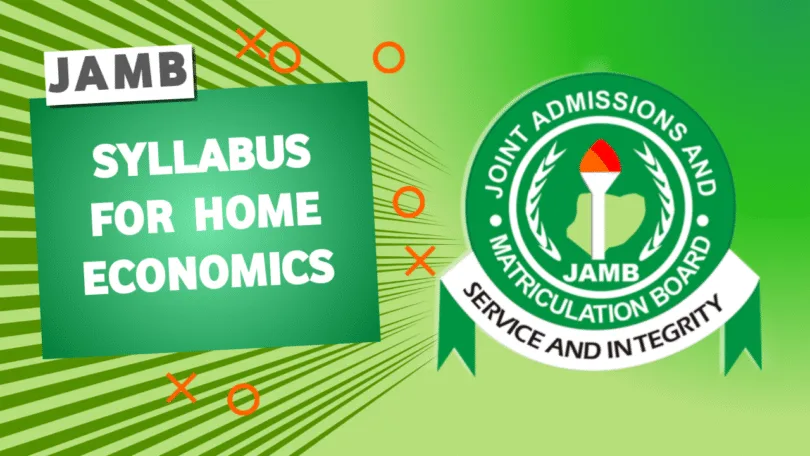If you are preparing for the JAMB UTME 2026/2027 and plan to write Economics, then you need to study with the official JAMB Syllabus for Economics 2026. This syllabus is the complete guide that shows you the exact topics JAMB will set questions from, so you don’t waste time on irrelevant materials.
On this page from utme2026.com, you’ll see the latest JAMB syllabus for Economics 2026, the topics it covers, and a free PDF download for offline study.
JAMB Economics Syllabus Overview
| Title | Detail |
|---|---|
| Exam Type | UTME |
| Exam Session | 2026/2027 |
| Syllabus Subject | Economics |
| File Format | |
| File Size | 250KB |
Why Use the JAMB Syllabus for Economics?
The syllabus is like a roadmap that directs your reading. Instead of guessing what to study, the syllabus shows you the approved topics that JAMB will test. Using it will:
- Help you stay focused and organized.
- Save you time by cutting off unnecessary reading.
- Guide your practice with JAMB past questions.
- Improve your confidence and chances of scoring high in Economics.
Topics Covered in the JAMB Economics Syllabus 2026
The syllabus contains all the areas JAMB expects candidates to master. The major sections include:
- The Meaning and Basic Concepts of Economics
- Tools of Economic Analysis
- Demand, Supply, and Market Equilibrium
- Theory of Production and Costs
- Market Structures
- National Income Accounting
- Money and Inflation
- Public Finance
- Economic Growth and Development
- International Trade and Balance of Payments
- Agriculture in Nigeria
- Industry and Business Organizations
- Population and Labour Market
- Natural Resources and the Environment
- Current Economic Reforms and Policies in Nigeria
For the detailed breakdown of each topic, download the free JAMB Economics Syllabus 2026 PDFbelow.
JAMB Syllabus for Economics 2026/2027 Full Breakdown
| Topic / Section | Subtopics / Contents | Objectives / What Candidates Should Be Able To Do |
|---|---|---|
| General Objectives |
1. Demonstrate knowledge & understanding of basic concepts, tools & their general applications to economics 2. Identify & explain structure, operations & roles of economic units & institutions (national/international) 3. Describe major economic activities: production, distribution, consumption 4. Identify & appraise economic problems of society 5. Develop ability to propose solutions to economic problems | – Achieve the goals above in exam answers |
| Economics as a Science |
a. Basic Concepts: Wants, Scarcity, Choice, Scale of Preference, Opportunity Cost, Rationality, Production, Distribution, Consumption b. Economic Problems: What, How, For Whom c. Application of Production Possibility Frontier (PPF) to economic problems | • Compare economic concepts • Interpret graphs/schedules • Identify economic problems • Propose solutions using PPF, etc. |
| Economic Systems |
a. Types: Free enterprise, Centrally planned, Mixed Economies b. Solutions to problems under different systems c. Contemporary issues: reforms, deregulation, economic policies in Nigeria | • Compare the systems • Apply to Nigeria’s context • Proffer solutions under each system |
| Methods & Tools of Economic Analysis |
a. Scientific Approach: Inductive & Deductive, Positive & Normative reasoning b. Basic Tools: Tables, Charts & Graphs c. Measures of Central Tendency: Mean, Median, Mode d. Measures of Dispersion: Range, Variance, Standard Deviation e. Merits & Demerits of these tools | • Distinguish reasoning types • Apply reasoning to real life • Use tools to interpret data • Analyse data & assess merits/demerits |
| The Theory of Demand |
a. Meaning & Determinants of Demand b. Demand Schedules & Curves c. Change in Demand vs Change in Quantity Demanded d. Types of Demand: Composite, Derived, Competitive, Joint e. Elasticity of Demand: Price, Income, Cross Elasticities – Determinants, Measurement, Nature, Applications | • Identify factors determining demand • Draw & interpret demand curves • Distinguish change in demand & quantity demanded • Compute elasticities • Interpret elasticity coefficients in real life • Understand importance to consumers, producers & government |
| The Theory of Consumer Behaviour |
a. Utility: Cardinal, Ordinal, Marginal, Total & Average b. Indifference Curves & Budget Line c. Consumer Equilibrium (Marginal Utility & Indifference Curve approaches) d. Income & Substitution Effects e. Consumer Surplus | • Distinguish utility concepts • Use marginal utility & indifference curve for equilibrium • Analyse shifts in budget line/indifference curves • Explain income & substitution effects • Apply consumer surplus concept |
| The Theory of Supply |
a. Meaning & Determinants of Supply b. Supply Schedules & Curves c. Change in Supply vs Change in Quantity Supplied d. Types of Supply: Joint, Complementary, Composite e. Elasticity of Supply: Determinants, Measurement, Nature, Applications | • Identify supply factors • Interpret supply curves • Distinguish change in supply & quantity supplied • Compute supply elasticity • Interpret elasticity in real life • Understand applications for government, producers, etc. |
| The Theory of Production |
a. Concepts: Total Product, Average Product, Marginal Product b. Laws of Production: Law of Diminishing Returns, Variable Proportions c. Scale of Production: Internal & External Economies d. Production Function, Returns to Scale e. Producer’s Equilibrium: Isoquant, Isocost, Marginal Rate of Technical Substitution | • Define production concepts • Explain laws of returns & scale of production • Analyse producer equilibrium with isoquant/isocost methods • Use marginal analysis in production decisions |
| The Theory of Costs & Revenue |
a. Cost Concepts: Fixed, Variable, Total, Average, Marginal b. Distinction: Accountants’ vs Economists’ Cost c. Short-run & Long-run Cost Curves d. Marginal Cost & Supply Curve e. Revenue Concepts: Total Revenue, Average Revenue, Marginal Revenue | • Distinguish cost types • Plot & interpret cost curves • Relate marginal cost to supply curve • Compute revenue measures • Analyse cost‐revenue relationships in pricing & output decisions |
| Market Structures |
a. Perfect Competition: Assumptions, Characteristics, Short-run & Long-run Equilibria b. Monopoly: Features, Price & Output under Monopoly, Discriminating Monopoly c. Monopolistic Competition d. Oligopoly (basic concepts) | • Describe each market type • Show equilibrium under each • Compare market structures • Evaluate strengths & weaknesses of each for producers & consumers |
| National Income |
a. Concepts & Measures of National Income b. Circular Flow of Income c. National Income Accounting: GDP, GNP etc d. Problems in measurement | • Define national income concepts • Use the circular flow model • Account for national income components • Critically assess measurement challenges |
| Money, Banking & Inflation |
a. Functions of Money b. Money Supply & Demand c. Role of Central Bank & Commercial Banks d. Inflation: Causes, Effects, Control | • Explain money functions • Analyse money supply/demand • Understand banking roles • Evaluate inflation dynamics & control measures |
| Public Finance / Government Economics |
a. Government Revenue & Expenditure b. Taxation: Principles, Types c. Public Debt d. Fiscal Policy & Budgeting | • Distinguish revenue vs expenditure • Explain tax types & principles • Analyse public debt issues • Evaluate fiscal policy tools & budgeting systems |
| Economic Growth & Development |
a. Meaning & Indicators b. Factors influencing growth & development c. Strategies for development d. Problems and constraints e. Role of agriculture, industry, services in Nigeria | • Identify growth vs development • Discuss key factors & indicators • Propose strategies • Analyse challenges in Nigeria’s development context |
| Agriculture, Industry & Natural Resources |
a. Role & importance in Nigeria b. Constraints & policies c. Resource depletion, environmental issues d. Sustainable development & management | • Appreciate the sector’s role • Analyse constraints • Propose resource management & sustainability solutions |
| International Trade & Finance |
a. Benefits & Costs of Trade b. Balance of Trade & Balance of Payments c. Trade Policies: Tariff, Quota, Exchange Rate d. International Organizations: WTO, IMF, World Bank | • Explain trade benefits & costs • Interpret BOT & BOP • Analyse effects of trade policies • Understand roles of international bodies |
| Business Organizations, Population & Miscellaneous |
a. Forms of business: Sole proprietorship, Partnership, Corporation, etc. b. Population: Growth, Distribution, Demographic Transition c. Miscellaneous: Concepts from current economic issues | • Distinguish business forms • Understand population economics • Keep abreast of current economics issues and relate to syllabus topics |
How to Download the JAMB Economics Syllabus 2026 PDF
Downloading the syllabus is very simple:
- Click on the download link available on this page.
- Save the PDF file to your device.
- Open it anytime to study—whether you are online or offline.
With the PDF, you can track your progress and prepare more effectively.
Tips for Using the JAMB Economics Syllabus Effectively
- Create a simple timetable and study consistently.
- Tackle difficult topics first before revising the easy ones.
- Practice with JAMB Economics past questions.
- Revise regularly to keep the topics fresh in your mind.
- Always use the latest syllabus to avoid missing out on new updates.
Conclusion
The JAMB Syllabus for Economics 2026 is the best tool to guide your preparation for UTME. It shows you exactly what to read, saves you time, and ensures you are ready for the exam. Don’t just study randomly—use the syllabus, practice with past questions, and stay consistent.
For more updates, past questions, and free study materials, always visit www.utme2026.com.
FAQs on JAMB Economics Syllabus
1. Is the JAMB Economics syllabus compulsory?
Yes. Every candidate writing Economics in UTME must study the syllabus because it contains the approved topics JAMB will use.
2. Can I download the JAMB Economics syllabus PDF for free?
Yes. It is free to download and you can save it for offline study.
3. How many questions will come from Economics in JAMB?
Economics has 40 questions in UTME, and they are all based on the topics in the syllabus.
4. Does the JAMB Economics syllabus change every year?
Not always. Sometimes it stays the same, but it’s important to check the latest version to avoid missing updates.
5. Where can I get the official JAMB Economics Syllabus 2026?
You can get it here on this page or by visiting www.utme2026.com.





